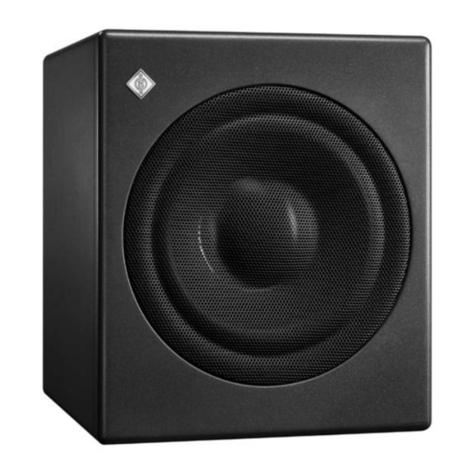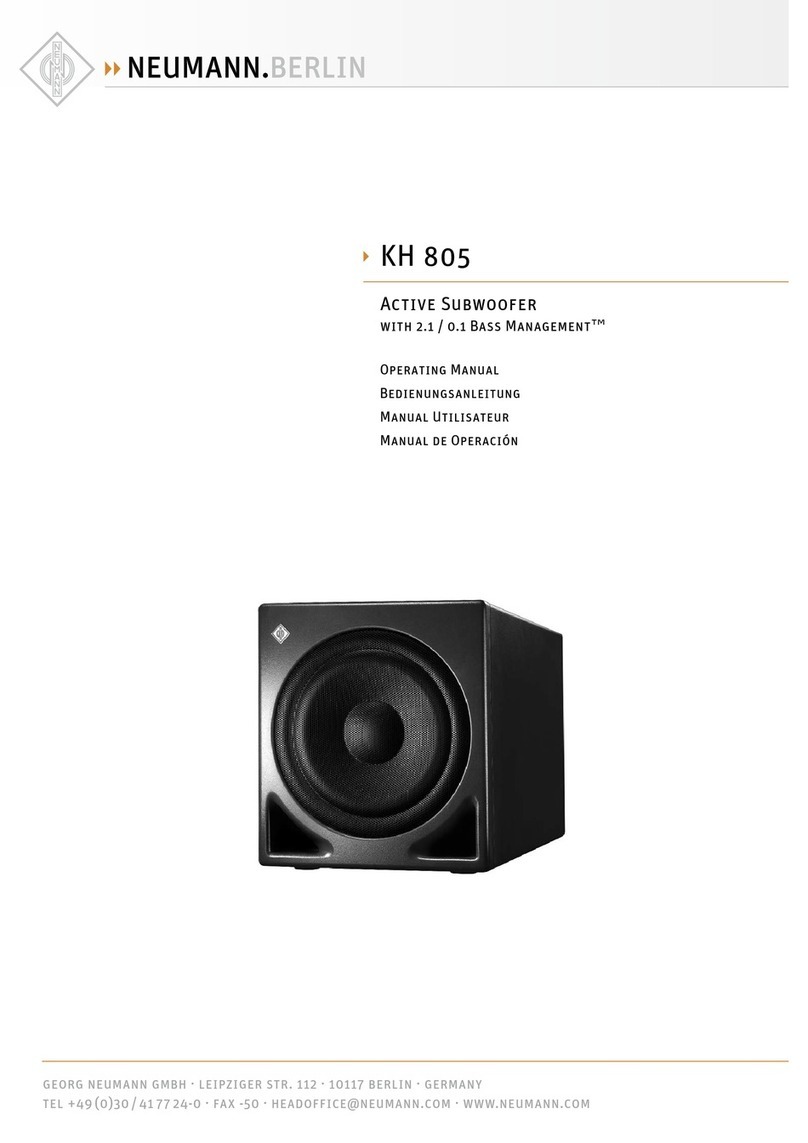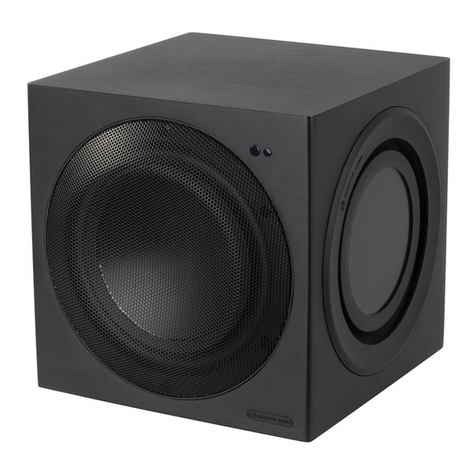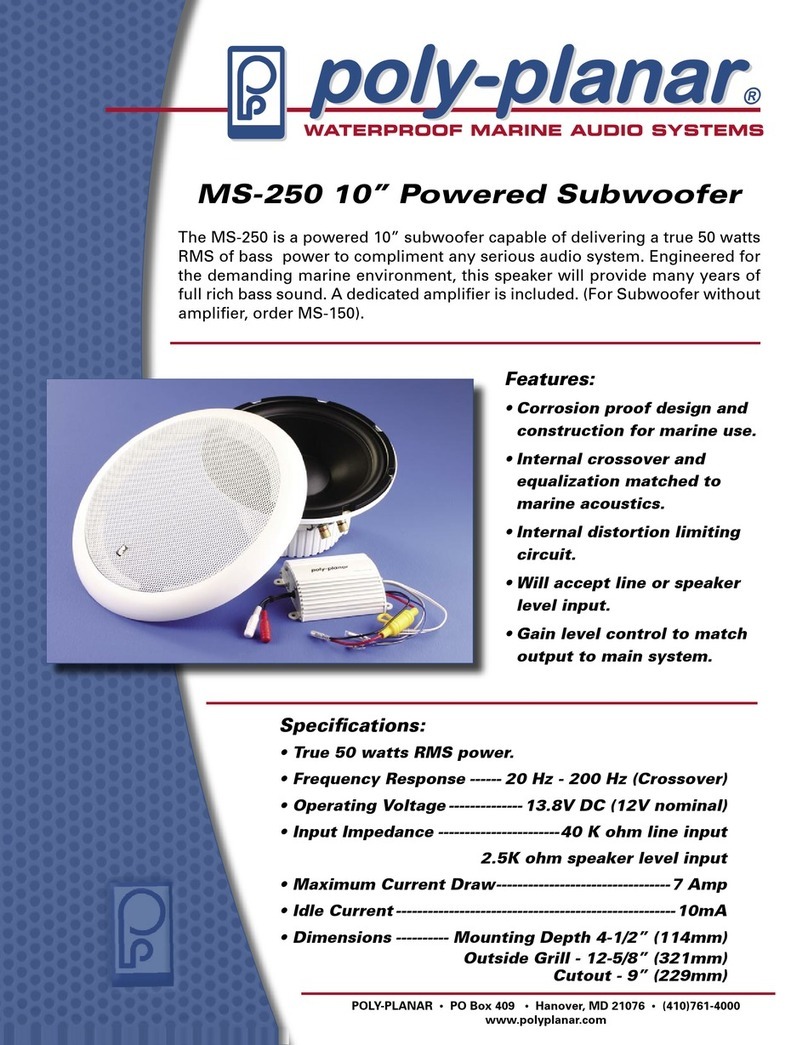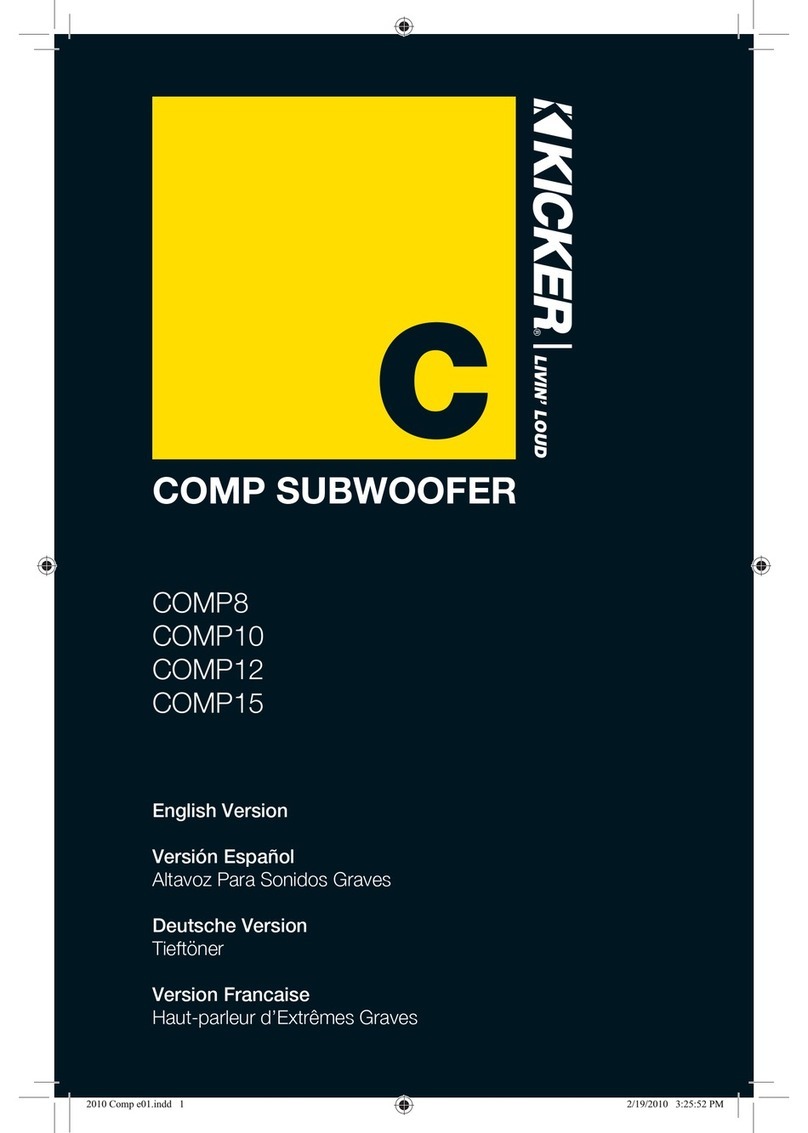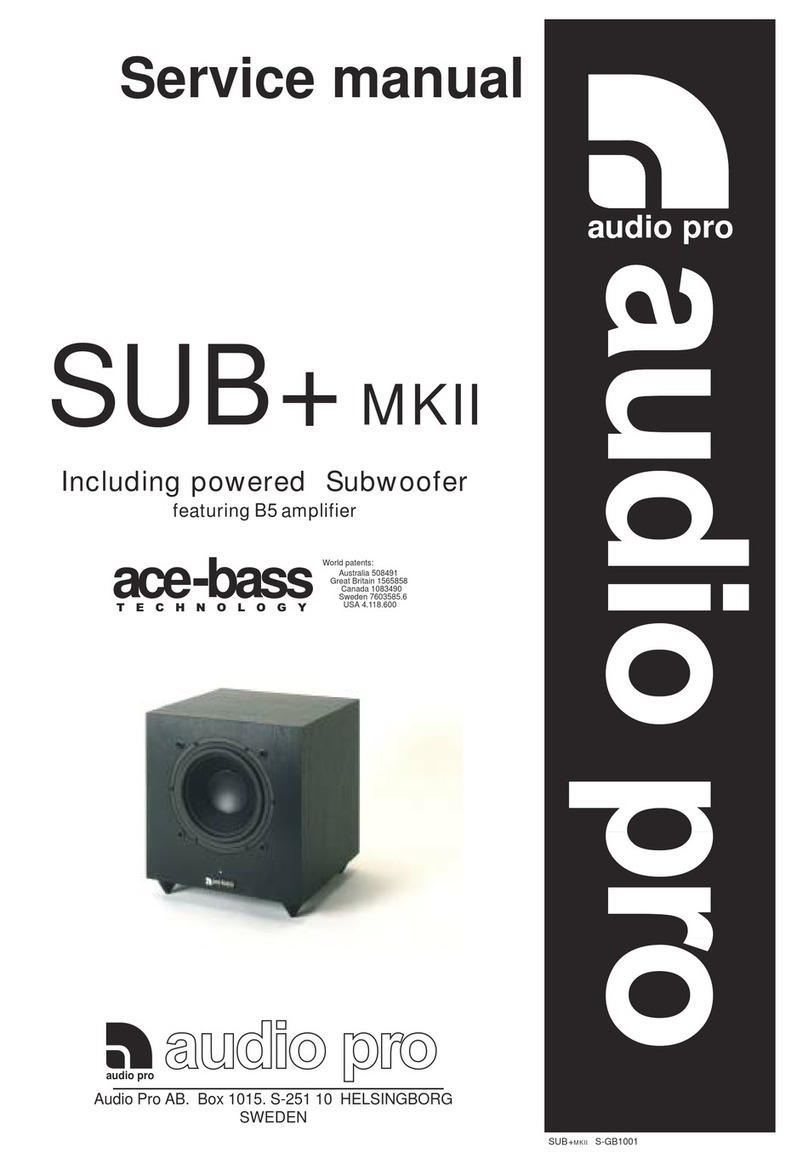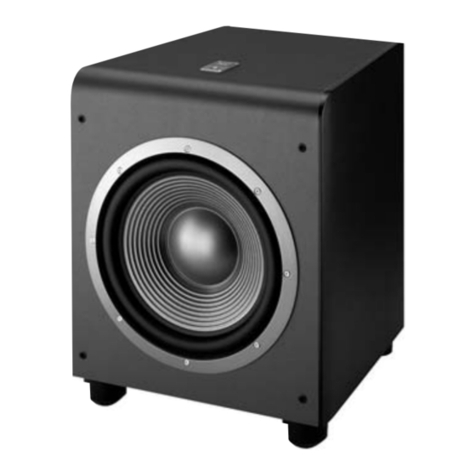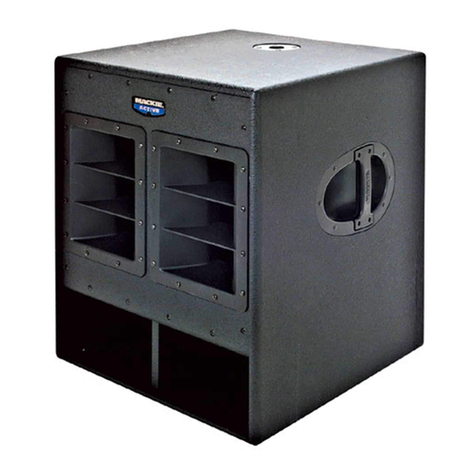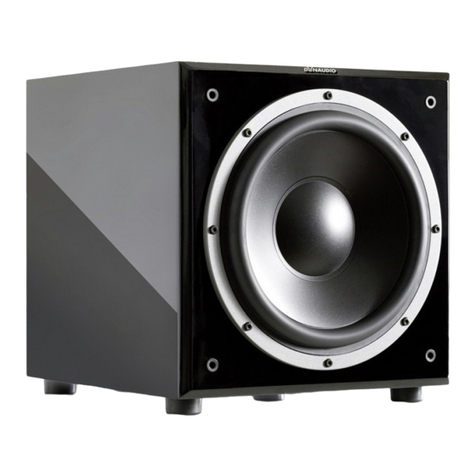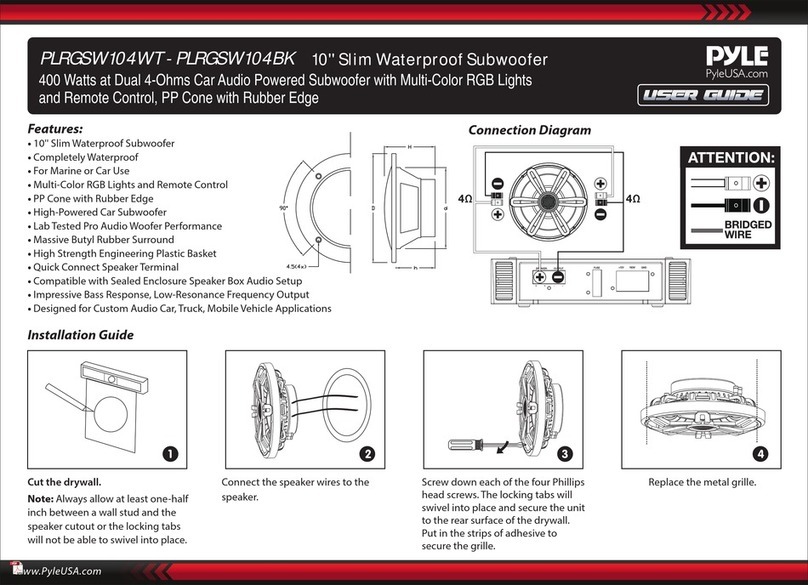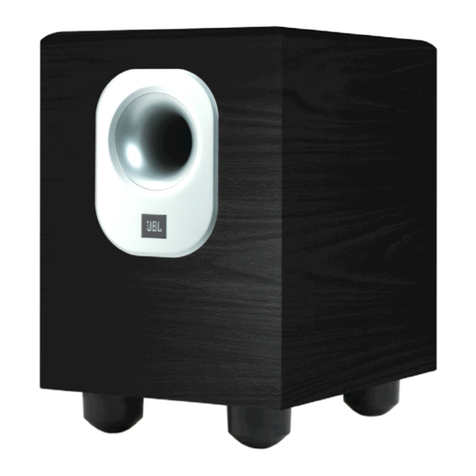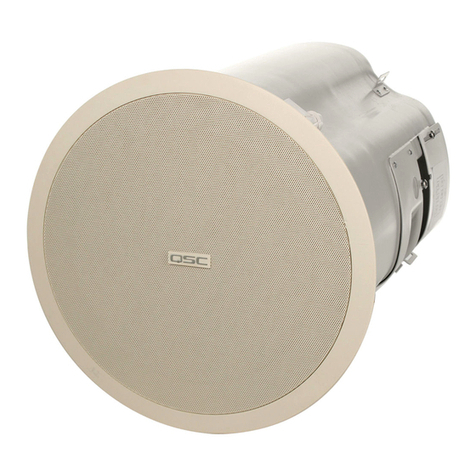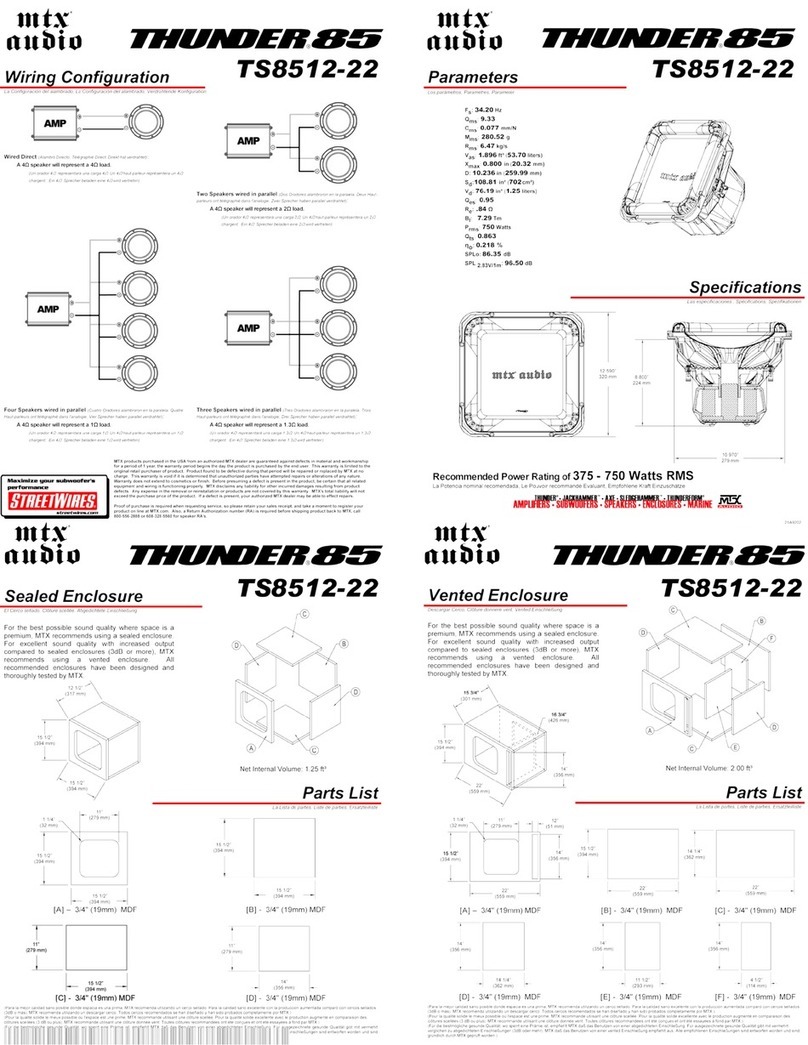Neumann.Berlin KH 870 User manual

georg neumann gmbh · ollenhauerstr. 98 · 13403 berlin · germany
KH 810/870
Active Subwoofer
with 7.1 High Definition Bass Management™
Operating Manual


KH 810/870 | 1
Important safety instructions ...............................................2
The KH 810/870 subwoofer .................................................4
Compatibility.........................................................4
Delivery includes ..........................................................4
Product overview ..........................................................5
Installing and connecting the KH 810/870 ....................................8
Preparing the subwoofer ...............................................8
Preparing the room....................................................8
Setting up the subwoofers..............................................9
Connecting the subwoofer.............................................11
Using the KH 810/870.....................................................17
Switching the subwoofer on/o ........................................17
Calibrating the subwoofer.............................................17
Compensating for larger time of flight (TOF) dierences ..................20
Using the bass management ...........................................20
Boosting the LFE channel and adjusting the LFE mode.....................20
Activating ground lift .................................................22
Remote-controlling the system.........................................22
Resetting the settings of the KH 810/870................................24
Cleaning and maintaining the subwoofer ................................25
Troubleshooting ..........................................................25
Specifications ............................................................26
Accessories ..............................................................28
Manufacturer Declarations .................................................29
Technical information & glossary ...........................................30
Contents
Appendix
System block diagram....................................................I
Pin assignment of the XLR socket .........................................I
Pin assignment of the REMOTE CONTROL AND RS-232 socket ..................I
Acoustical measurements .............................................II-IV
EN

2| KH 810/870
Important safety instructions
1. Read these instructions.
2. Keep these instructions. Always include these instructions when passing the product on to
third parties.
3. Heed all warnings.
4. Follow all instructions.
5. Do not use this apparatus near water.
6. Only clean the product when it is not connected to the mains power supply. Clean only with
a dry cloth.
7. Always ensure a free air flow through the ventilation openings on the rear of the product.
Install in accordance with the manufacturer’s instructions.
8. Do not install near any heat sources such as radiators, heat registers, stoves, or other
apparatus (including amplifiers) that produce heat.
9. Do not defeat the safety purpose of the polarized or grounding-type plug. A polarized plug
has two blades with one wider than the other. A grounding type plug has two blades and
a third grounding prong. The wide blade or the third prong are provided for your safety.
If the provided plug does not fit into your outlet, consult an electrician for replacement of
the obsolete outlet. Always connect to a mains socket outlet with a protective earthing
connector.
10. Protect the power cord from being walked on or pinched, particularly at plugs, conve-
nience receptacles, and the point where they exit from the apparatus.
11. Only use attachments/accessories specified by the manufacturer.
12. Use only with the cart, stand, tripod, bracket, or table specified by the manu-
facturer, or sold with the apparatus. When a cart is used, use caution when
moving the cart/apparatus combination to avoid injury from tip-over.
13. Unplug this apparatus during lightning storms or when unused for long periods of time.
14. Refer all servicing to qualified service personnel. Servicing is required when the appara-
tus has been damaged in any way, such as power supply cord or plug is damaged, liquid
has been spilled or objects have fallen into the apparatus, when the apparatus has been
exposed to rain or moisture, does not operate normally, or has been dropped.
15. To completely disconnect this apparatus from the AC mains, disconnect the power supply
cord plug from the AC receptacle.
16. WARNING: To reduce the risk of fire or electric shock, do not expose this apparatus to rain
or moisture.
17. Do not expose this equipment to dripping or splashing and ensure that no objects filled
with liquids, such as vases, are placed on the equipment.
18. The mains plug of the power supply cord shall remain readily accessible.
The label shown on the right is attached to the rear of
the product.
The symbols on this label have the following meaning:
Presence of uninsulated dangerous voltage within the product’s enclo-
sure that may be of sucient magnitude to constitute a risk of fire or
electric shock.
Never open the product or remove the grilles fitted to the product as
there is a risk of electric shock. There are no user serviceable parts
inside. Refer servicing to your Neumann service partner.
Read and follow the safety and operating instructions contained in the
operating manual.
Hazard warnings
on the rear of
the product
EN

KH 810/870 | 3
• Ensure that the room in which you use this product is wired in accordance with the local
electrical code and checked by a qualified inspector.
• Only use the product indoors.
• Do not install the product in hot, humid, or excessively dusty locations, in direct sunlight or
in locations where it is exposed to externally generated vibrations.
• Do not place burning objects (e.g. candles) on top of or near the product.
• If condensation has formed on the product, e.g. because it was moved from a cold environ-
ment to a warm one, allow the product to acclimatize to room temperature before using it.
• Do not overload wall outlets and extension cables as this may result in fire and electric
shock.
WARNING
Danger of hearing damage due to sudden high sound pressure levels!
Audio signals that are present at switch-on of the product or that can be present during
operation, can create sudden, very high sound pressure levels which can damage your
hearing.
XAlways lower the output level of the audio source before connecting it to the subwoofer
or starting it (pressing “play”).
This subwoofer can be used for commercial purposes. Commercial use is subject to the rules
and regulations of the trade association responsible. Neumann, as the manufacturer, is there-
fore obliged to expressly point out possible health risks arising from use. This subwoofer is
capable of producing sound pressure levels exceeding 85 dB(A) SPL. This is the sound pres-
sure corresponding to the maximum permissible level which is by law (in some countries)
allowed to aect your hearing for the duration of a working day (8 hours). It is used as a basis
according to the specifications of industrial medicine. Higher sound pressure levels and/or
longer durations can damage your hearing.
At higher sound pressure levels, the duration must be shortened in order to prevent hearing
damage. The following are signs that you have been subjected to excessive sound pressure
levels for too long a time.
• You can hear ringing or whistling sounds in your ears.
• You have the impression (even for a short time only) that you can no longer hear high fre-
quencies (temporary threshold shift).
WARNING
Interference due to magnetic fields!
This product generates stronger permanent magnetic fields that can interfere with cardiac
pacemakers and implanted defibrillators (ICDs).
XAlways maintain a distance of at least 4" (10 cm) between the subwoofer and the cardiac
pacemaker or implanted defibrillator.
Intended use of the product includes:
• having read this operating manual, especially the chapter “Important safety instructions”,
• using the product within the operating conditions and limitations described in this operat-
ing manual.
“Improper use” means using the product:
• other than as described in this operating manual, or
• under operating conditions which dier from those described herein.
This will invalidate the guarantee.
Installation
High sound
pressure levels
Magnetic fields
Intended use
EN

4| KH 810/870
The KH 810/870 subwoofer
Thank you for purchasing a Neumann subwoofer. Neumann subwoofers are designed to com-
plement Neumann’s extensive range of monitors. They can be used in music, broadcast, and
post production studios for tracking, mixing, and mastering. They can be positioned next to a
wall or flush mounted into a wall, and can be mixed freely in multi-channel systems with other
loudspeakers and subwoofers from the Neumann Studio Monitor Systems range.
The built-in 7.1 Channel High Definition Bass Manager™ is compatible with all formats, from
mono to the latest 7.1 High Definition systems. Eight analog channels ensure flexible intercon-
nectivity for modern studios. Four-mode LFE channel processing ensures maximum compati-
bility across all formats. 4th order crossovers and flexible acoustical controls allow for seam-
less system integration. The built-in volume control allows for centralized system adjustment
independent of the source.
The latest high eciency amplifiers and acoustical components have been used to ensure the
most accurate sound reproduction possible. Neumann products are designed for longevity so
we hope you enjoy many happy years of using this product.
Compatibility
The 7.1 Channel High Definition Bass Manager™ is compatible with the following formats:
• 7.1, 7.0 HD (Blu-ray, video gaming)
• 7.1 Theatrical (5 front channels)
• 6.1, 6.0 (DVD, DVD Audio, SACD)
• 5.1, with an additional 2.0 2-channel stereo system
• 5.1, 5.0 (DVD, multi-channel CD, HDTV, video gaming)
• 3/1.0 (LCRS)
• 2.0 (2-channel stereo, reproduced with or without a subwoofer)
• 1.0 (mono)
Larger audio systems can be built using several subwoofers.
Delivery includes
1 KH810 subwoofer or KH 870 subwoofer
3 Mains cables (European, UK and US version)
1 Operating manual
1 Supplement “Getting Started Quickly”
The current operating manual as well as the supplement “Getting Started Quickly” can also be
downloaded from the “Downloads” area on the product page at www.neumann.com.
Note that imperial dimensions are approximate.
EN

KH 810/870 | 5
Product overview
1
2
3 3
1 Neumann logo
2 Metal grille
3 Bass reflex ports
EN

6| KH 810/870
EQUALIZER
PARAMETRIC
SERIAL NUMBER
OUTPUT
INPUT
PIN 1 CONNECTED
INPUT
GROUND LIFT
DIRECT IN
SUM
LFE / SUM
RIGHT
BACK
LEFT
BACK
RIGHT
SURROUND
LEFT
SURROUND RIGHT CENTER LEFT
DESIGNED IN GERMANY -
MADE IN IRELAND
There are no user serviceable parts
inside this product. Repairs should only
be performed by authorized service
personnel. Options and accessories
are fitted at the user's own risk.
All safety and warning notices found in
the user manual should be observed.
Specifically, do not expose to moisture,
liquids, flames, heat, vibration, dust, or
direct sunlight. Do not block or cover
heatsinks or vents, and leave adequate
space for ventilation.
Check mains power voltage selection
before connecting to correctly earthed
mains power.
This loudspeaker is capable of
producing a sound pressure level in
excess of 85 dB. This may cause
permanent hearing damage so user
caution is recommended. Noise
exposure is a function of SPL and time,
so observe local regulations when
listening at high levels for a long time.
Hearing protection may be required.
CAUTIONS AND WARNINGS
ACTIVE STUDIO SUBWOOFER
7.1 CHANNEL HIGH DEFINITION BASS MANAGER
AC 100-120 V
AC 220-240 V
ON
OFF
Internal fuse type and rating:
5x20 mm SB 5.0 A
Max. power consumption:
290 W (KH 810) / 550 W (KH 870)
AC 100-120 V /
220-240 V
~ 50-60 Hz
OPTIONAL
POWER
ON / OFF
REMOTE
MAINS POWER
MAINS VOLTAGE
SELECTION
0
-12
40 Hz
B8 9 0 A
7
6
5
4
4 MAINS VOLTAGE SELECTION switch
5 MAINS POWER switch
6 OPTIONAL REMOTE POWER ON/OFF socket
7 IEC mains socket with protective ground contact
8 Sockets
INPUT | LEFT, CENTER, RIGHT
INPUT | LEFT SURROUND, RIGHT SURROUND
INPUT | LEFT BACK, RIGHT BACK
9 INPUT | DIRECT IN / LFE /SUM socket
0 OUTPUT | SUM socket
A Sockets
OUTPUT | LEFT, CENTER, RIGHT
OUTPUT | LEFT SURROUND, RIGHT SURROUND
OUTPUT | LEFT BACK, RIGHT BACK
B REMOTE CONTROL AND RS-232 socket
EN

KH 810/870 | 7
EQUALIZER
PARAMETRIC
SERIAL NUMBER
OUTPUT
INPUT
PIN 1 CONNECTED
INPUT
GROUND LIFT
DIRECT IN
SUM
LFE / SUM
RIGHT
BACK
LEFT
BACK
RIGHT
SURROUND
LEFT
SURROUND RIGHT CENTER LEFT
DESIGNED IN GERMANY -
MADE IN IRELAND
There are no user serviceable parts
inside this product. Repairs should only
be performed by authorized service
personnel. Options and accessories
are fitted at the user's own risk.
All safety and warning notices found in
the user manual should be observed.
Specifically, do not expose to moisture,
liquids, flames, heat, vibration, dust, or
direct sunlight. Do not block or cover
heatsinks or vents, and leave adequate
space for ventilation.
Check mains power voltage selection
before connecting to correctly earthed
mains power.
This loudspeaker is capable of
producing a sound pressure level in
excess of 85 dB. This may cause
permanent hearing damage so user
caution is recommended. Noise
exposure is a function of SPL and time,
so observe local regulations when
listening at high levels for a long time.
Hearing protection may be required.
CAUTIONS AND WARNINGS
ACTIVE STUDIO SUBWOOFER
7.1 CHANNEL HIGH DEFINITION BASS MANAGER
AC 100-120 V
AC 220-240 V
ON
OFF
Internal fuse type and rating:
5x20 mm SB 5.0 A
Max. power consumption:
290 W (KH 810) / 550 W (KH 870)
AC 100-120 V /
220-240 V
~ 50-60 Hz
OPTIONAL
POWER
ON / OFF
REMOTE
MAINS POWER
MAINS VOLTAGE
SELECTION
0
-12
40 Hz
C D E F G
H
S
R
Q
P
O
N
M
L
K
J
I
D
C INPUT GROUND LIFT switch
D Ventilation openings
E POWER ON LED (red)
•lights up red: subwoofer is switched on and
ready for operation
•flashes red slowly: protection system is active,
output level is reduced by 6 dB
•flashes red rapidly: subwoofer booting-up just after switch-on
•is o: subwoofer is switched o
F BASS MANAGEMENT LED (green)
•lights up green: bass management activated
•is o: bass management disabled
G BASS MANAGEMENT switch
H REAR CH BASS MANAGEMENT switch
I VOLUME CONTROL switch
J TEST SIGNAL switch
K SUBWOOFER GAIN | OUTPUT LEVEL switch
L SUBWOOFER GAIN | INPUT GAIN potentiometer
M SUBWOOFER PHASE switch
N SUBWOOFER PHASE rotary switch
O PARAMETRIC EQUALIZER switch
P Potentiometers
PARAMETRIC EQUALIZER | GAIN
PARAMETRIC EQUALIZER | Q
PARAMETRIC EQUALIZER | FREQUENCY
Q LOW CUT potentiometer
R LFE GAIN switch
S LFE MODE rotary switch
EN

8| KH 810/870
Installing and connecting the KH 810/870
Have the product installed and connected by a specialist. Due to his/her technical training,
know-how and experience as well as knowledge of relevant provisions, regulations and stan-
dards, the specialist must be able to assess assigned tasks, recognize potential hazards and
ensure appropriate safety measures. The following safety and mounting instructions are
addressed to this specialist.
CAUTION
Danger of injury and material damage due to tipping/dropping of the product!
If improperly mounted, the product and/or the mounting hardware (e.g. rack) can tip over
or drop down.
X
Always have the product mounted by a qualified specialist according to local, national
and international regulations and standards.
X
Use the mounting systems recommended by Neumann and always provide sucient addi-
tional protection against tipping or dropping by means of safety wires.
CAUTION
Damage to the product due to overheating!
If air cannot circulate properly through the ventilation openings Don the rear of the prod-
uct, the power amplifiers may overheat leading to premature activation of the thermal pro-
tection system which limits the maximum output level of the subwoofer. In rare cases, dam-
age to the product may also occur.
XNever cover the ventilation openings D.
XWhen installing the product into tight spaces such as wall recesses, maintain an air gap
of at least 2" (5 cm) around the subwoofer’s backplate to ensure a free air flow through
the ventilation openings.
For information on installation, please refer to the supplied “Getting Started Quickly”
supplement. This will help you set up the subwoofers and loudspeakers in a way that
will give you the best acoustic performance from the system. For further information on
setting up subwoofers and loudspeakers, please refer to the “Questions & Answers”
section at www.neumann.com.
Preparing the subwoofer
CAUTION
Risk of staining surfaces!
Some surfaces treated with varnish, polish or synthetics may suer from stains when they
come into contact with other synthetics. Despite a thorough testing of the synthetics used
by us, we cannot rule out the possibility of staining.
XDo not place the KH 810/870 on delicate surfaces.
The bottom of the subwoofer features rubber feet which reduce the risk of scratching the sur-
face and the subwoofer cabinet, and acoustically isolate the subwoofer from the surface.
If you want to hide the subwoofer:
XUse a thin open weave cloth. To provide visual cover, you can use two layers of the cloth.
Preparing the room
X
Arrange all acoustically relevant surfaces and objects symmetrically on either side of the
listening axis of the room (left/right).
XMinimize the sound that is reflected back to the listening position by using angled surfaces
and/or acoustical treatment.
This product has been optimized for use in recording studios. In order to avoid aecting
the quality of reproduction, make sure that the product is used in an EMC environment.
EN

KH 810/870 | 9
Setting up the subwoofers
Choosing the type of set up
The bass reflex ports are located on the front panel of the subwoofer, allowing the subwoofer
to be either set up in a room or flush mounted into a wall recess.
Flush mounting the subwoofer into a wall recess oers the following advantages:
• A solid wall boosts the level of the subwoofer in the room which can be compensated by
reducing the output level of the subwoofer. This also reduces distortion resulting in a cleaner
sound reproduction.
• Reflections from the wall behind the subwoofer are eliminated so that the frequency
response becomes smoother.
• The subwoofer does not occupy space in the room.
If you want to flush mount the subwoofer into a wall recess:
X
Have the wall constructed by an experienced acoustical engineer. At least the following points
should be observed:
• The wall should be solid (stone, brick, concrete, several layers of gypsum or MDF).
• Ensure a free air flow through the ventilation openings Don the rear of the subwoofer
(see warning note on page 8) or remote locate the subwoofer electronics using the
Neumann REK 3 remote electronics kit and an SC cable (available in dierent lengths, see
“Accessories” on page28).
Using one or several subwoofers
XUse ...
one subwoofer several subwoofers
... if your room does not oer sucient
space for several subwoofers.
... if you need to move left and right
along the mixing console, or if there are
several listening positions along a large
format mixing console.
... if you prefer an easier installation of
your system.
... if you require a higher output power
or less distortion with the same output
power.
... to suppress lateral modes or cross
modes in the room by means of a Plane
Wave Bass Array (PWBA™).
... if many smaller cabinets are easier to
position than one large cabinet.
To reduce low-frequency distortion, the uncalibrated output level of your subwoofer
should always be higher than the output level of your loudspeakers. We recommend
using arrays with several subwoofers, in which case the uncalibrated maximum output
level of the subwoofer array should also be higher than the maximum output level of all
the loudspeakers in the system. The subwoofers can then be calibrated to a lower out-
put level resulting in lower distortion and correspondingly cleaner low-frequency
reproduction.
For information on building a balanced system, please refer to the “Product Selection
Guide” at www.neumann.com.
EN

10 | KH 810/870
Positioning the subwoofers
Regardless of whether you are setting up one or several subwoofers:
X
Always ensure that the distance dwall between the wall behind the subwoofer and the sub-
woofer’s front is less than 0.8 m.
If you are setting up one subwoofer:
XPosition the subwoofer against the front wall, slightly left or right of the middle of the front
wall and between the left and right loudspeakers.
If you are setting up several subwoofers as a Plane Wave Bass Array™(PWBA™):
XUse two to four subwoofers for smaller rooms and three to four subwoofers for larger rooms.
XSet up the subwoofers along the front wall within half a wavelength of each other. The max-
imum spacing of the subwoofer cabinets is determined by the setting of the LFE mode
(see page 20):
Setting Max. spacing of the subwoofer cabinets
LFE → SUB + L/R (>80) approx. 2 m (6'6")
LFE → SUB ONLY (<80) approx. 2 m (6'6")
LFE → SUB ONLY (<120) approx. 1.4 m (4'6")
DIRECT IN → SUB ONLY approx. 1.4 m (4'6")
If you observe the stated spacing, the subwoofers form a cylindrical source and generate
a plane wave down the room, a so-called Plane Wave Bass Array™(PWBA™). The PWBA™
reduces stationary waves between the side walls, improves the bass reproduction and
suppresses lateral room resonances.
For examples of set up positions and distances, please refer to the supplied “Getting
Started Quickly” supplement.
You can correct excessive low frequency energy in the room using the potentiometer
SUBWOOFER GAIN| INPUT GAIN Land the switch SUBWOOFER GAIN | OUTPUT LEVEL K
(cf. page31).
If you set up several subwoofers, you can utilize their mutual coupling to achieve an acoustical
gain. The following acoustical gains are possible:
Number of subwoofers Acoustical gain
10.0 dB
26.0 dB
39.5 dB
412.0 dB
Positioning and orienting subwoofers and loudspeakers
Subwoofers are omni-directional in their typical pass band as the generated wavelength is
long compared to the surface producing the sound, therefore it does not matter in which direc-
tion the subwoofer is oriented when placed in the listening environment.
dwall
Utilizing the
acoustical gain
EN

KH 810/870 | 11
For your loudspeakers, however, an accurate positioning and orientation is vital.
XPosition your loudspeakers as follows:
System Position and orientation
2.0 (stereo) ±30°
5.1 ITU-R BS.775-1:
0°, ±30°, ±110° (±10°)
(center, front left/right, surround left/right)
ANSI/SMPTE 202M:
0°, ±22.5°, arrays to the surround left and to the surround right,
plus optional subwoofer(s)
6.1 as 5.1 systems plus 180° (back center)
7.1 0°, ±30°, ±90°, ±150°
(center, front left/right, side left/right, back left/right)
For detailed information on the positioning and orientation of your loudspeakers, please refer
to the operating manuals of the loudspeakers.
If your subwoofers cannot be placed at the same distance from the listening position as the
loudspeakers, time-of-flight dierences will occur.
XAvoid distance dierences of > 2m (6'6").
X
Compensate for time-of-flight dierences as described in the chapter “Calibrating the phase”
on page 19.
Connecting the subwoofer
Connecting the subwoofer to an audio source
XUse balanced XLR cables to connect the corresponding sockets INPUT 8of the KH810/870
to the audio source.
XUse an XLR adapter (not supplied) to connect unbalanced cables (e.g. RCA cables).
Use the
following wiring if you want to make your own XLR adapter:
Wiring Pin Signal
Output (RCA) Input (XLR-M)
1Audio ground
2Signal +
3Signal -
The level delivered by devices with RCA outputs (-10 dBV) is usually less than the studio level
(+4 dBu):
X
If necessary, use active unbalanced-to-balanced converters in order to be able to connect
devices with unbalanced signals.
Connecting
unbalanced
cables
EN

12 | KH 810/870
Connecting loudspeakers to the subwoofer
For a simplified representation, the following connection examples show small loudspeakers
in combination with the KH810 subwoofer. Each of the examples only shows one possible
combination of loudspeakers and subwoofers. For information on building a balanced system,
please refer to the “Product Selection Guide” at www.neumann.com. In addition, the sub-
woofer electronics are shown separately from the KH810 to provide better clarity.
XUse balanced XLR cables to connect the corresponding sockets OUTPUTAof the subwoofer
to the input sockets of the loudspeakers, as shown in the following diagrams.
Left /
Right
Left Back/
Right Back
Left Surround /
Right Surround
Center /
LFE
A
B
A
B
A
B
A
B
Sum Output
Right
Left
Right Back
Right Surrou
Left Back
Center
Left Surround
7.1 High Definition
Bass Manager
Σ
Right
Center
Right Surround
LFE
Right Back
Left Surround
Left
Left Back
Sum Output
Σ
Right
Center
Right Surround
Right Back
Left Surround
Left
Left Back
7
.
1 High Definition
Bass Manager
Internal Subwoofer Signal or
Driver Cable (DC nn) when Remote
Electronics Kit (REK 3) is used
Optional additional subwoofers
The diagram “Connection of a 7.1 system” also demonstrates that the built-in 7.1 Channel High
Definition Bass Manager™ can be used to build 1.0, 2.0, 3/1.0, 5.0, 5.1, 6.0, 6.1 and 7.1 Theat-
rical systems.
Σ
Right
Center
Right Surround
LFE
Right Back
Left Surround
Left
Left Back
Sum Output
Right
Center
Right Surround
Right Back
Left Surround
Left
Left Back
7
.
1 High Definition
Bass Manager
Optional additional subwoofers
Internal Subwoofer Signal or
Driver Cable (DC nn) when Remote
Electronics Kit (REK 3) is used
Connection of a
7.1 system
Simultaneous
connections of
5.1 and 2.0 signals
EN

KH 810/870 | 13
The diagram “Simultaneous connections of 5.1 and 2.0 signals” shows the possibility of an
additional bass extension for a 2.0 signal:
XFirst, set up a 5.1 system.
XConnect a stereo signal to the unused sockets INPUT | LEFT BACK and RIGHT BACK8.
X
Connect an additional pair of loudspeakers to the unused sockets OUTPUT | LEFT BACK and
RIGHT BACKA.
You now have a separate 2.0 system that can use the subwoofer.
XSend either a 5.1 or a 2.0 signal to the system.
X
Try to keep the two pairs of loudspeakers connected to the sockets INPUT | LEFT/INPUT | LEFT
BACK and INPUT | RIGHT/INPUT | RIGHT BACK at the same distance from the listening position
(see diagram) so that dierent phase settings are not required.
Connecting several KH 810/870
To increase the number of subwoofers in a system and to make a Plane Wave Bass Array™, you
can connect the KH810/870 to additional KH 810/870 subwoofers. In such a set-up, the input
signals are only connected to the first subwoofer in the chain. The LFE mode and bass manage-
ment is defined in the first subwoofer.
X
Connect your audio source to the sockets INPUT | LEFT/RIGHT BACK, LEFT/RIGHT
SURROUND, LEFT, CENTER and RIGHT 8 and to the socket INPUT | DIRECT IN / LFE / SUM 9
of the first subwoofer.
X
Connect the socket OUTPUT | SUM0to the analog input socket INPUT | DIRECT IN / LFE /
SUM 9of another KH 810/870 subwoofer.
XSet the rotary switch LFE MODE Sof all additional subwoofers to “DIRECT IN -> SUB ONLY”.
This prevents double filtering of the audio signal.
XMake sure that all other settings such as level, phase, EQ, ... are also set on each of the addi-
tional subwoofers. This information is not daisy-chained from the first subwoofer (master) to
the additional subwoofers.
Right
Center
Right Surround
LFE
Left Back
Right Back
Left
Left Surround
Sum Output
Σ
Right
Center
Right Surround
Left Back
Right Back
Left
Left Surround
7.1 High Definition
Bass Manager
Sum
Output
Sum
Input
Sum
Output
Sum
Input
LFE Mode =
LFE -> SUB L/R (> 80) or
LFE -> SUB ONLY (< 80) or
LFE -> SUB ONLY (< 120) or
DIRECT IN -> SUB ONLY
Sum
Input
LFE Mode = DIRECT IN -> SUB ONLY
Sum
Output
Internal Subwoofer Signal or
Driver Cable (DC nn) when Remote
Electronics Kit (REK 2) is used
EN

14 | KH 810/870
Using subwoofers in a 4-way system
To build a larger system:
XInstall the subwoofers and loudspeakers like columns:
Left
INPUT LEFT INPUT CENTER INPUT RIGHT
OUTPUT LEFT OUTPUT CENTER OUTPUT RIGHT
INPUT INPUT INPUT
LFE LFE LFE
Right
Center
LFE
XConnect the channels Left, Center, Right of your audio source to the subwoofers according
to their physical position (see diagram above):
• Connect the channel Left to the socket INPUT | LEFT 8of the left subwoofer, connect the
channel Center to the socket INPUT | CENTER 8of the middle subwooferand connect the
channel Right to the socket INPUT | RIGHT 8of the right subwoofer.
XUse a Y-cable (not supplied) to connect the LFE channel of the audio source to the sockets
INPUT | DIRECT IN / LFE /SUM9of all three subwoofers.
To tilt the loudspeakers, you can use Neumann mounting hardware such as, for example,
the LH 36.
The subwoofers should be acoustically calibrated so that they smoothly extend the bass
response of their respective main loudspeaker. As three subwoofers are being used to repro-
duce one signal, there is a 9.5 dB acoustical boost for the LFE channel only. The LFE channel
level should be adjusted at the audio source by –9.5 dB or +0.5 dB so that the reproduction
level (0 or +10dB) is consistent with the main channels.
EN

KH 810/870 | 15
Connecting/disconnecting the subwoofer to/from the mains power supply
To connect the KH 810/870 to the mains power supply:
XMake sure that the switch MAINS POWER 5is set to “OFF”.
XMake sure that the switch MAINS VOLTAGE SELECTION 4is set to the correct position:
“AC 100/120 V” if your mains voltage is 100 V or 120V or
“AC 220/240 V” if your mains voltage is 220 V, 230 V or 240V.
XIf necessary, carry out further steps for a remote switch-on/switch-o (see below).
XConnect the IEC connector of the supplied mains cable to the IEC mains socket 7.
KH 810
OPTIONAL
REMOTE
POWER ON/OFF
AC 100-120 V
AC 220-240 V
ON
OFF
AC 100-120 V /
220-240 V
~ 50-60 Hz
OPTIONAL
POWER
ON / OFF
REMOTE
MAINS POWER
MAINS VOLTAGE
SELECTION
Power Source
5
4
7
XConnect the mains plug of the mains cable to a suitable wall socket.
To disconnect the KH 810/870 from the mains power supply:
XSet the switch MAINS POWER 5to “OFF”.
XPull the mains plug out of the wall socket.
Mounting the subwoofer electronics externally
If you distribute the subwoofers around the room but wish to have centralized access to the
operating controls of the subwoofer electronics or if you set up your subwoofers so that easy
access to the subwoofer electronics is not possible, you can mount the latter externally:
XUse the Neumann REK3 remote electronics kit together with an SC cable (available in dier-
ent lengths, see “Accessories” on page28).
XProceed as described in the operating manual of the REK 3.
EN

16 | KH 810/870
Preparing the subwoofer for remote on/o switching
XHave your Neumann service partner enable the remote on/o switching function inside the
subwoofer.
XUse a Euroblock connector (not supplied) to connect a two-core cable (12 V DC) to the socket
OPTIONAL REMOTE POWER ON/OFF 6 (socket pin assignment shown on the left).
For further information on remotely switching the subwoofer on/o, please refer to
page 17.
Preparing the subwoofer for remote control/RS-232 control
CAUTION
Material damage due to improper use of cables!
If you insert a network cable that is connected to the KH 810/870 into a network socket, the
network device can be damaged. If network signals are transmitted to the KH 810/870 via
a network cable, the KH 810/870 can be damaged.
X
Only connect the KH 810/870 to Neumann remote controls or devices that deliver a RS-232
signal using a high-quality Neumann RC CAT5 cable (see below). Do not use a “crossover”
type of CAT5 cable.
You can remote control the KH 810/870 via the Neumann NRC 1 remote control (see “Accesso-
ries” on page 28) or control it via an RS-232 signal. For more information, please refer to
the operating manuals of the remote controls and to page 22.
XConnect the NRC 1 remote control or the RS-232 control to the socket REMOTE CONTROL AND
RS-232 B. Use Neumann RC cables with Neutrik EtherCon connectors (see “Accessories” on
page28). These cables are available in dierent lengths, have been designed for heavy-
duty use and provide maximum freedom of movement.
The pin assignment of the socket REMOTE CONTROL AND RS-232 Bcan be found at the
end of this operating manual.
To remote control more than one subwoofer, an SEA 1 is required (see “Accessories” on
page 28). This device duplicates control signals across multiple subwoofers. For
more information, see the SEA 1 operating manual.
OPTIONAL
POWER
ON / OFF +
-
REMOTE
EN

KH 810/870 | 17
Using the KH 810/870
Switching the subwoofer on/o
You can switch the KH 810/870 on and o using the switch MAINS POWER 5or remotely.
KH 810
OPTIONAL
REMOTE
POWER ON/OFF
ON
OFF
OPTIONAL
POWER
ON / OFF
REMOTE
MAINS POWER
XSet the switch MAINS POWER 5 to:
• “ON” to switch the subwoofer on. The LED POWER ONEflashes for 3 seconds, during
which the subwoofer is muted (see below). The LED POWER ONEthen lights up red.
• “OFF” to switch the subwoofer o. The LED POWER ONEgoes o.
There is a three second delay before sound can be heard from the KH 810/870 in order
to avoid noises (pops) from preceding equipment switched on at the same time. Con-
versely, switching o the subwoofer immediately mutes the audio.
X
Carry out all steps described in the chapter “Preparing the subwoofer for remote on/o
switching” on page 16.
XMake sure that the switch MAINS POWER 5is set to “ON”.
XApply 12V DC to remotely switch the subwoofer electronics on or apply 0V DC to remotely
switch the subwoofer electronics o.
Calibrating the subwoofer
Before using your system for the first time and whenever you change the physical conditions in
your studio, carry out the following steps:
XAdjust the frequency response and the level of the loudspeakers before calibrating the sub-
woofer (see the operating manual of the loudspeakers):
Application Recommended frequency response Commentary
Studio flat -
Film X-curve shape Cf. ANSI/SMPTE 202M:
the shape of the X-curve
depends on the size of the room
Home subjective evaluation Not necessarily a flat response,
a gently downward sloping
response with increasing
frequency is often preferred
All the loudspeakers in the system should have the same level at the listening position. This
is often measured using a pink noise test signal that is set to -18 dBFS (Europe) or -20 dBFS
(USA) on the mixing console’s output level meters and a sound level meter set to “C-weighted”
and “slow”.
On/o switching
using the switch
MAINS POWER 5
Remote on/o
switching
EN

18 | KH 810/870
XCalibrate the frequency response, the phase and the acoustical level of the subwoofer.
To do so, choose one of the following methods:
1. Calibration using an acoustical measurement system
Calibrating the frequency response, phase and sound pressure level by means of an
acoustical measurement system should always be your first choice since it yields the
highest accuracy. This method is described below.
2. Calibration using Neumann test signals
In the absence of an acoustical measurement system, you can calibrate the settings of
your subwoofer using Neumann test signals (see page 19).
3. Calibration using music signals and an 80 Hz test signal
A calibration by means of music signals is also possible but should always be the last
choice. In this case, use the built-in 80 Hz test signal generator to calibrate the phase
(see page 19).
If you are using several subwoofers, it is possible that the same setting is not valid for all
subwoofers.
XCalibrate each subwoofer separately.
XIf necessary, move the subwoofer and/or the main loudspeakers.
XIf necessary, apply acoustical treatment to the source of any reflections.
Calibration using an acoustical measurement system
The settings of the potentiometer SUBWOOFER GAIN | INPUT GAIN Lrecommended in
the following table are valid for the following settings of your Neumann loudspeaker:
INPUT GAIN: “0 dB” and OUTPUT LEVEL: “100 dB SPL at 1m for 0 dBu”. For information
on how to set your Neumann loudspeaker, please refer to its operating manual. If the
mentioned values cannot be set on your loudspeaker, adjust the subwoofer accordingly.
The frequency response of a subwoofer depends on its position in the room and on the room
geometry. The same subwoofer installed in dierent positions in the same room may require
dierent acoustical control settings.
XAdjust the frequency response of the subwoofer at your listening position. To do so, proceed
as follows:
X
Make sure that the switch SUBWOOFER GAIN | OUTPUT LEVEL Kis set to “100 dB SPL at 1m
for 0 dBu”.
X
First, set the potentiometers SUBWOOFER GAIN | INPUT GAIN Land LOW CUT Qto the
following settings. These settings can be used as a starting point for further adjustment:
Subwoofer position Setting of potentiometer
SUBWOOFER GAIN | INPUT GAIN L
Setting of potentiometer
LOW CUT Q
In a corner -8 dB -4 dB
Next to or flush
mounted in an
acoustically solid
wall (e.g. brick,
concrete)
-4 dB -2 dB
Next to or flush
mounted in an
acoustically soft
wall (e.g. gypsum)
-2 dB 0 dB
Free standing in an
untreated room
-2 dB 0 dB
Free standing in a
well-treated room
0 dB 0 dB
Calibrating the
frequency
response
0
-12
40 Hz
EN
Table of contents
Other Neumann.Berlin Subwoofer manuals
